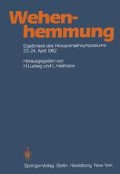Zusammenfassung
Die als Wehenhemmer eingesetzten β-Sympathomimetika mit bevorzugter Wirkung auf die β 2-Rezeptoren haben typische Wirkungen auf den Kohlehydratstoffwechsel: Glykogenolyse in der Leber (9), Anstieg des Blutglucosespiegels durch den Abbau des Leberglykogens bzw. gesteigerte Gluconeogenese (13, 16, 17), Lactatanstieg durch Glykogenolyse im Skelettmuskel (15, 17) und Anstieg des Insulinspiegels durch direkte Stimulation oder als Reaktion auf den erhöhten Blutglucosespiegel (1,9).
Mit Unterstützung der Deutschen Forschungsgemeinschaft
Access this chapter
Tax calculation will be finalised at checkout
Purchases are for personal use only
Preview
Unable to display preview. Download preview PDF.
Literatur
Beck JC, Johnson JWC, Mitzner W, Lee PA, London WT, Sly DL (1981) Glucocorticoids, hyper-insulinemia, and fetal lung maturation. Am J Obstet Gynecol 139:465
Dawes GS (1968) Foetal and neonatal physiology. Year Book Medical Pulishers, Chicago
Fischer JH (1977) Untersuchungen zur Reifeabhängigkeit der Sauerstoffmangel-Toleranz. Fortschr Med 95:1833
Heilmann L, Siekmann U, Ludwig H (im Druck) Die Hämodynamik und die Fließeigenschaften des Blutes unter den Betamimetika Hexoprenalin und Fenoterol.
Hüter J, Rippert C, Meyer C (1972) Wehenhemmung mit welchem Betamimetikum (Berotec, Ritodrine, Dilatol)? Geburtshilfe Frauenheilkd 32:97
Isselhard W, Merguet H, Palm K (1962) Bestimmung des Gesamtglykogens neben säurelöslichen Metaboliten in Perchlorsäure-Organhomogenaten. Z Ges Exp Med 136:174
Isselhard W, Fischer JH, Kapune H, Stock W (1973) Metabolic patterns of several tissues of rabbits and guinea pigs during postnatal development. Biol Neonate 22:201
Lipshitz J, Broyles K, Whybrew WD, Ahokas RA, Anderson GD (1982) Placental transfer of 14C-hexoprenaline. Am J Obstet Gynecol 142:313
Ogata ES (1981) Isoxsuprine infusion in the rat: Alterations in maternal, fetal and neonatal glucose homeostasis. J Perinat Med 9:293
Richter R, Wiest W (1978) Tokolyse mit Berücksichtigung der Nebenwirkungen. Gynäkologe 11:29
Shelley HJ (1961) Glykogen reserves and their changes at birth and in anoxia. Br Med Bull 17: 137
Shelley HJ (1973) The use of chronically catheterized foetal lambs for the study of foetal metabolism. In: Comline KS, Dawes GS, Nathanielsz PW (eds) Foetal and neonatal physiology. Cambridge University Press, Cambridge, p 360
Spellacy WN, Cruz AC, Buhi WC, Birk SA (1978) The acute effects of ritodrine infusion on maternal metabolism: Measurements of levels of glucose, insulin, glucagon triglycerides, cholesterol, placental lactogen, and chorionic gonadotropin. Am J Obstet Gynecol 131:637
Streller I (1975) Zur Pharmakologie von Partusisten (Th 1165 a) am Uterus. In: Jung H, Klöck FK (Hrsg) Th 1165 a (Partusisten) bei der Behandlung in der Geburtshilfe und Perinatologie. Thieme, Stuttgart, S 1
Traunecker W (1975) Extrauterine pharmakologische Wirkungen von Partusisten (Th 1165 a). In: Jung H, Klöck FK (Hrsg) Th 1165 a (Partusisten) bei der Behandlung in der Geburtshilfe und Perinatologie. Thieme, Stuttgart, S 167
Unbehaun V, Conradt A, Schlotter CM, Schneider V (1974) Stoffwechselveränderungen während Infusion von Th 1165 a. Z Geburtshilfe Perinatol 178:118
Weidinger H, Wiest W (1973) Modellvorstellung zur Wirkung betasymphathikomimetischer Substanzen. Z Geburtshilfe Perinatol 177:223
Wiest W, Weidinger H, Zsolnai B, Somogyi J, Rominger KL (1977) Diaplacental transfer of Partusisten in humans. In: Weidinger H (ed) Labour inhibition. Betamimetic drugs in obstetrics. Fischer, Stuttgart, p 47
Editor information
Editors and Affiliations
Rights and permissions
Copyright information
© 1982 Springer-Verlag Berlin Heidelberg
About this paper
Cite this paper
Fischer, J.H., Wolff, F. (1982). Zur glykogenolytischen Wirkung der Tokolyse an der fetalen Leber. Vergleichsuntersuchungen von Hexoprenalin, Fenoterol, Buphenin und Ritodrin an der Ratte. In: Ludwig, H., Heilmann, L. (eds) Wehenhemmung. Springer, Berlin, Heidelberg. https://doi.org/10.1007/978-3-642-68784-6_55
Download citation
DOI: https://doi.org/10.1007/978-3-642-68784-6_55
Publisher Name: Springer, Berlin, Heidelberg
Print ISBN: 978-3-642-68785-3
Online ISBN: 978-3-642-68784-6
eBook Packages: Springer Book Archive

